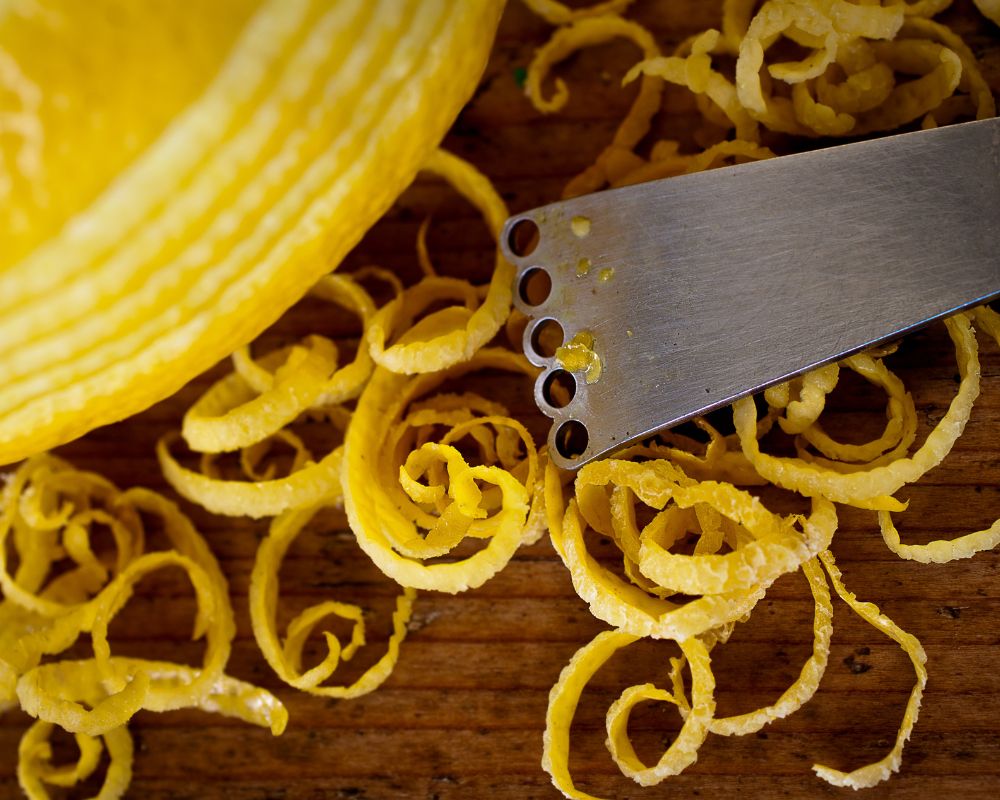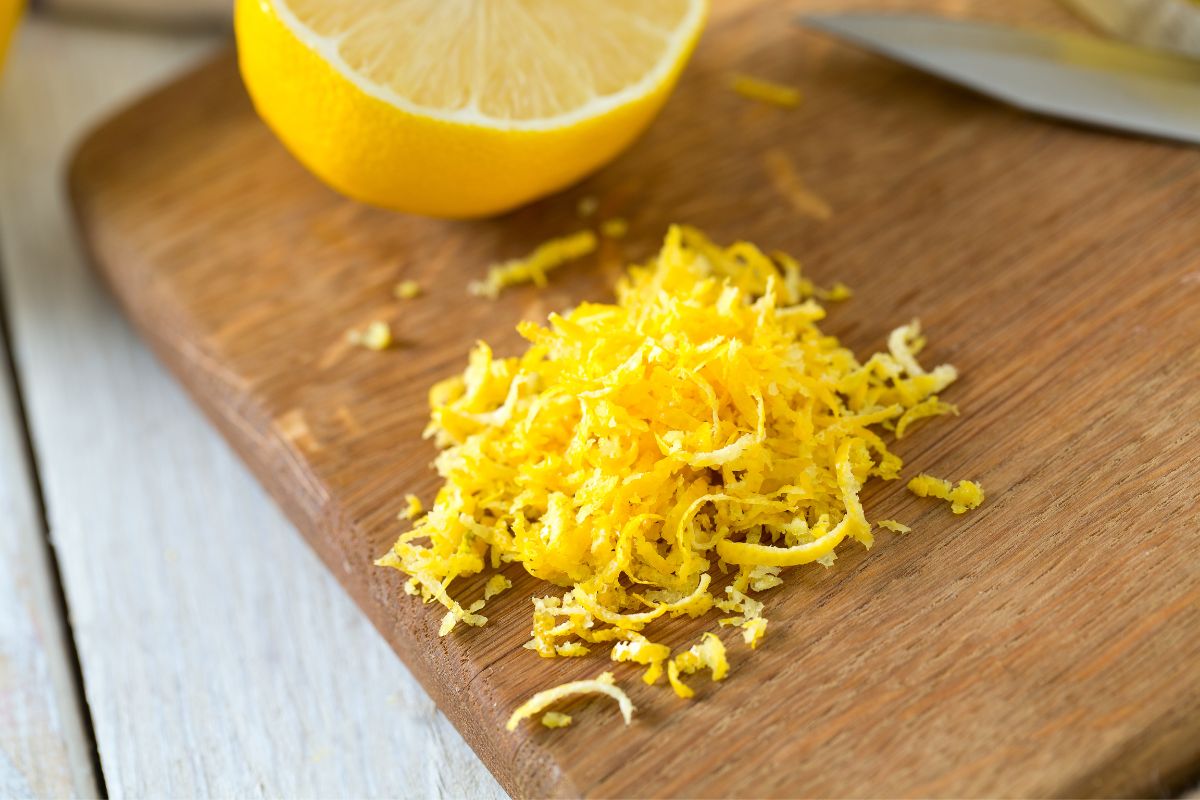If you don’t have lemon zest, the best substitutes you can use are fresh lemon juice, lemon extract, dried lemon peel, and zest from other citrus fruits.
Table of Contents
What exactly is lemon zest?
Lemon zest refers to the small shavings you get from the bright yellow outer layer of the citrus fruit. The finely shredded rind (or skin) has lots of essential oils, giving it a bolder flavor than a lemon extract. Still, it has less acidity than tart juice.
Whether you use a knife, a vegetable peeler, a Microplane, or a box greater when zesting a lemon, be careful not to cut too deep so as not to hit the white pith. The pith is that soft substance found in the inner layer of the lemon peel — and is responsible for adding an unpleasant bitter taste that could ruin the flavor you’re trying to achieve.
What does lemon zest taste like?
Many recipes — especially those behind sweet and savory dishes — use lemon zest. This zest has an intense lemon and citrus flavor and fragrance with few hints of bitterness.
When cooked, the heat will cause the zest to release its oils and infuses the dish with a distinct blend of floral and citrus flavors. When added raw (as in the case of salads and pasta), it will provide mild bitterness and a delicious citrus aroma.
Lemon zest embodies the vibrant yellow color of the fruit itself — a tiny pinch can add a bright, tangy lemon flavor to a culinary piece.
What is a good substitute for lemon zest?
Don’t have lemons to zest? If you’re wondering what a great substitute for lemon zest is, these are your top four options:
- Another citrus
- Lemon extract
- Lemon juice
- Dried lemon peel
| Another citrus | Less acidic than lemon zest | Ideal for shortcakes, meringues, salad dressings |
| Lemon extract | More acidic than lemon zest | Ideal for marinades |
| Lemon juice | More acidic than lemon zest | Ideal for recipes that are already filled with liquid |
| Dried lemon peel | Similar in acidity, but also bitter since it contains the pith | Ideal for sweet and savory recipes |
1. Another citrus

Instead of fresh lemon zest, you can use other citrus zest, such as orange zest and lime zest, to add a tangy twist to a meal you’re preparing.
You need 1 tablespoon of lime zest to replace 1 tablespoon of lemon zest. Sometimes you may need more because the zest of other citruses doesn’t pack a punch like lemon zest.
Orange zest works best for sweet recipes like shortcakes and meringues (you can also use the zest of grapefruit). Meanwhile, you can use the lime zest for savory dishes like creamy lemon spaghetti or as a garnish for salad dressings and drinks.
2. Lemon extract

Manufacturers make a lemon extract by soaking lemon peels in alcohol. This extract adds lemony notes to a dish but be careful not to overuse it. About ½ teaspoon of this extract is equivalent to 1 teaspoon of lemon zest.
The lemon extract is a good substitute for lemon zest in marinades. If you’re making Mediterranean grilled lemon chicken, you can use this extract as an alternative.
3. Lemon juice

Fresh lemon juice is more acidic than lemon zest and lemon extract. One teaspoon of lemon zest is equivalent to 2 tablespoons of lemon juice. To balance out the tartness of this substitute, you can add a pinch of sugar.
Lemon juice is best for recipes that already contain liquid (e.g., lemon curd) or when they’re savory and extra liquid is acceptable (e.g., steamed lemon broccoli).
4. Dried lemon peel

The dehydrated lemon zest carries a more intense, bitter flavor than regular lemon zest. While you can use it as a substitute in sweet and savory recipes, remember that 1 teaspoon of dried lemon peel is equivalent to 1 tablespoon of fresh lemon zest.
You can grind the dried peel into a powder and add them to your salad, dips, or sauteed vegetables.
Can you leave lemon zest out of a recipe?
Based on personal experience, if the recipe doesn’t spotlight lemon zest, you can leave this ingredient out. But if you want to add a unique flavor to what you’re making — especially if it involves sweet and savory recipes — consider using a lemon zest substitute.
When shouldn’t you substitute lemon zest?
There are instances when you shouldn’t substitute lemon zest with any of the alternatives. That is when the recipe calls for a lot of zest (like lemon poppyseed pancake).
Using a substitute in place of lemon zest could give your final output a different flavor. In the case of baked goods, alternatives like lemon juice and extract can also disrupt the overall texture and consistency.
Frequently Asked Questions
Is lime zest a substitute for lemon zest?
Lime zest is a good substitute because it also has a strong lemony flavor like lemon zest (though it has more acidity).
Where to purchase lemon extract?
You can buy a lemon extract online or at a grocery store. If you buy it from a physical store, you can find it in the baking supplies section.
How much lemon juice is equal to 1 lemon zest?
A medium-sized lemon produces about 3 tablespoons of lemon juice. To get the equivalent of 1 tablespoon of lemon zest, you need 6 tablespoons of lemon juice.
Can I make dried lemon peel at home?
Here are some steps to take if you want to make dried lemon peel at home. First, wash and dry some lemons and peel or zest them. Then, dry them in the oven or on the counter. If you use the oven, you must wait 30 minutes to an hour. The peels will naturally dry over several days if you’re drying them on the counter.
How do you zest a lemon if you don’t have a zester?
You can use a zester, a box grater, or a Microplane. Carefully run the lemon rind back and forth across the blade while rotating the fruit as you go. Alternatively, you can use a vegetable peeler and a sharp knife. First, peel off the lemon into bigger strips, then use the knife to chop it into smaller strips. You can also use a paring knife to peel the skin off the lemon.
Can you buy lemon zest in a jar?
You can purchase lemon zest in a jar, and it’s available online and in physical stores. However, nothing beats the zest from a fresh lemon.

